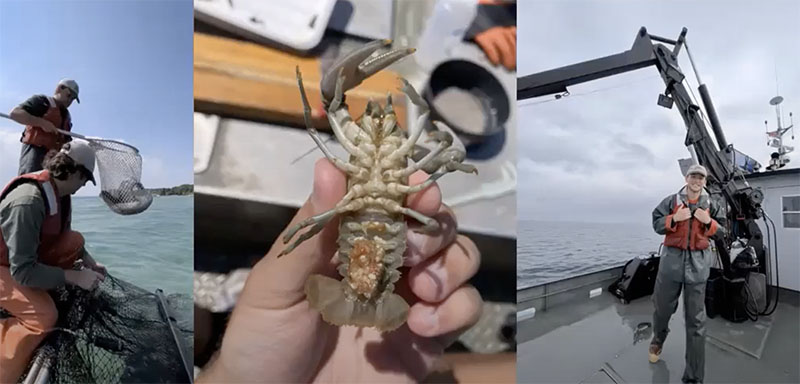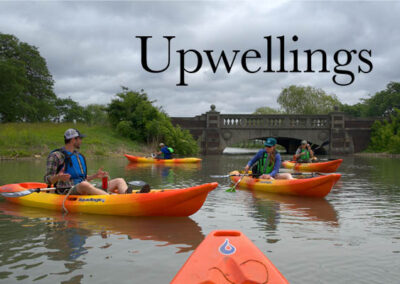From teaching Detroit youth about air pollution to collecting fish stomachs, Michigan Sea Grant’s interns had a busy summer.
Michigan Sea Grant’s undergraduate environmental internship program coordinates and funds students working on summer Great Lakes stewardship projects. For each internship, a student works with an academic institution, business, nonprofit, or government agency that helps support and guide the project.
In 2022, Michigan Sea Grant supported 10 interns, representing 7 colleges and universities. Their projects ranged from studying water distribution in an urban forest to evaluating yellow perch populations in Lake Michigan.

Credit: Caleb O’brien
The internship program can provide students with funding to work with organizations and projects they’re already passionate about. Cassidy Beach built her internship on existing relationships she had with staff at the Thunder Bay National Marine Sanctuary in Alpena.
She wrote in a blog post, “Two summers ago, I received my Open Water Dive certification with Stephanie Gandulla, who is now my research mentor here. She welcomed me like family into the sanctuary’s crew and now I get to play an important role here.”
Cassidy enjoyed many new experiences during her internship, including working on the sanctuary’s glass-bottomed boat and meeting passengers from a nearby Viking Cruises ship. However, her primary work focused on an exciting venture: the first-ever acidification research in the Great Lakes. Acidification is a major concern for global oceans today, and as Cassidy wrote in her post, “When I heard about the importance of this project, I knew I wanted to be a part of it. What makes this internship even more special is that we are researching and teaching the public about a very pressing topic right in my hometown!”
Six of the interns also showcased their projects during an in-person symposium on August 8 at the University of Michigan’s Ann Arbor campus. Each intern delivered a brief presentation about their work and answered questions from the audience. A consolidated recording of the symposium is available online; timestamps in the video description jump to specific portions of the agenda.
 Becky Barsky, a student at the University of Michigan, presented her work with steelhead in Lake Michigan. She partnered with the Michigan Department of Natural Resources at their Charlevoix Fisheries Research Station to study how tagging and tracking technology could help shed light on steelhead population decline.
Becky Barsky, a student at the University of Michigan, presented her work with steelhead in Lake Michigan. She partnered with the Michigan Department of Natural Resources at their Charlevoix Fisheries Research Station to study how tagging and tracking technology could help shed light on steelhead population decline.
Becky’s internship experience affirmed that she’s on the right career path: “I’m definitely interested in continuing [in fisheries research],” she said during her presentation. She added that she loved working on Great Lakes issues and wants to learn about other watersheds and ecosystems as well.
 Ethan Scheys, a rising sophomore at University of Detroit Mercy, also found validation through his internship experience. He partnered with Palmer Park, an urban forest in Detroit, to study how the wooded area affects the movement of water through the region. He collected and analyzed data using Google Earth Engine, a digital tool that combines satellite imagery and geophysical datasets. Ethan reflected that this kind of data processing is “relatively new. If I had a question, it was really hard to get an answer.” He rose to the challenge by teaching himself a new programming language, taking online courses, and tailoring his research questions to make the most of Google Earth Engine’s analytical power.
Ethan Scheys, a rising sophomore at University of Detroit Mercy, also found validation through his internship experience. He partnered with Palmer Park, an urban forest in Detroit, to study how the wooded area affects the movement of water through the region. He collected and analyzed data using Google Earth Engine, a digital tool that combines satellite imagery and geophysical datasets. Ethan reflected that this kind of data processing is “relatively new. If I had a question, it was really hard to get an answer.” He rose to the challenge by teaching himself a new programming language, taking online courses, and tailoring his research questions to make the most of Google Earth Engine’s analytical power.
Ethan found the challenges worthwhile. “I thoroughly enjoyed this project,” he concluded. “I have some experience in biology research, and being able to incorporate the computer science knowledge that I have … I really want to continue bridging those two worlds.”
 Sarah Krzemien recently graduated from Central Michigan University. Her internship was housed at the Detroit Zoological Society, where she worked with Citizen Science Educator Mike Reed and fellow intern Kyle Martin to develop community outreach and educational programs. “I’m from southeast Michigan, so I knew that air pollution was a big concern in the area,” Sarah told the symposium audience. “I was able to work with community members to create a program to help educate others, especially children, about the problems with air pollution and some solutions that were already implemented in their communities.”
Sarah Krzemien recently graduated from Central Michigan University. Her internship was housed at the Detroit Zoological Society, where she worked with Citizen Science Educator Mike Reed and fellow intern Kyle Martin to develop community outreach and educational programs. “I’m from southeast Michigan, so I knew that air pollution was a big concern in the area,” Sarah told the symposium audience. “I was able to work with community members to create a program to help educate others, especially children, about the problems with air pollution and some solutions that were already implemented in their communities.”
She had an “aha moment” while delivering a program for K-12 students at the annual Detroit Youth Day on Belle Isle. She and Kyle had created the program to help students identify common tree species and celebrate their role in cleaning up air pollution. “I was able to see the direct impact my program was having right away. A student came up to us at the station and realized that one of the trees he’d identified was a tree in his backyard. He was really excited that something already in his backyard was helping clean the air.”
Sarah also created a survey to gauge community interest in having multilingual signs and programming at local parks. Southeast Michigan is home to many Spanish and Arabic speakers, and having park signs in multiple languages can help residents learn and feel more connected to their community. She also spoke with park professionals who are already thinking through these signage choices: “One of the landscape architects that I talked to, the park she was in charge of … is putting in tactile and braille signage for visually impaired community members, which I thought was really cool.”

Credit: Tariq Speights
Kyle is studying environmental science and zoology at Eastern Michigan University. He designed and hosted a community event in Ann Arbor called “School of Green: Herpetofauna,” which brought together dozens of participants for presentations about environmental stewardship and conservation of Michigan’s reptiles and amphibians. The event included live animal interactions facilitated by staff from the Huron-Clinton Metroparks Mobile Learning Center. During his symposium presentation, Kyle talked about “being able to break down some of the stigmas around reptiles and amphibians. A lot of the people going to the School of Green event let me know they were kind of nervous about having live snakes there. But at the end of it, a lot of people felt much more comfortable.” Take a deeper dive into Kyle’s School of Green event.
Michigan Sea Grant Research Program Manager Mike Fraker coordinates the annual internships and organized the symposium. “We hope these internships help students gain experiences they otherwise wouldn’t, so it is always great to hear that the students enjoyed their internships and did so much with them,” said Mike after hearing the presentations.
Michigan Sea Grant Director Tom Johengen extended special thanks to the Michigan Department of Natural Resources and the Detroit Zoological Society, which sponsored multiple interns in the 2022 cohort. “We want to acknowledge their tremendous contributions and support,” said Tom. He also thanked the mentoring faculty that worked with students on their individual projects.
The 2022 interns may be wrapping up their work, but Michigan Sea Grant is already setting the stage for the next round of applications. The application window for 2023 summer funding will open later this year. Watch Michigan Sea Grant’s social media feeds or internship webpage for more information.


